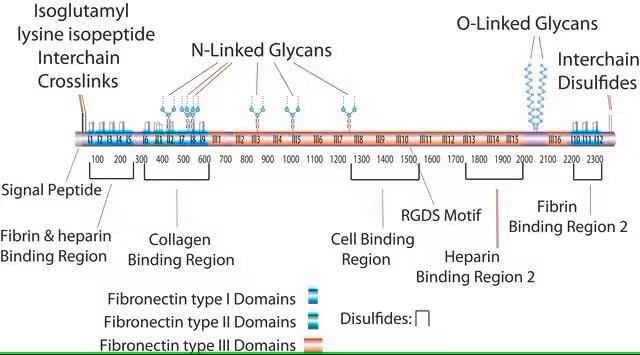F2733
Human Fibronectin
from human plasma, liquid, FITC labeled, suitable for cell culture
Synonyme(s) :
Fibronectin
Se connecterpour consulter vos tarifs contractuels et ceux de votre entreprise/organisme
About This Item
Code UNSPSC :
12352202
Nomenclature NACRES :
NA.75
Produits recommandés
Nom du produit
Fibronectin-FITC, FITC-labeled human plasma fibronectin, Suitable for cell culture
Niveau de qualité
Forme
liquid
Conditions de stockage
protect from light
Conditions d'expédition
dry ice
Température de stockage
−20°C
Description générale
Fibronectin is purified from human plasma (Cat. No. F0895). The protein is modified to contain covalently linked Fluorescein 5-isothiocyanate (Cat. No. F7250).
Fibronectin, also known as Cold-insoluble globulin, is a large glycoprotein of the extracellular matrix that is coded by FN1 gene. It is expressed in the plasma and at the cell surface. Fibronectin is a ubiquitous and essential component of the extracellular matrix (ECM) and plays a vital role during tissue repair. Fibronectin functions both as a regulator of cellular processes and an important scaffolding protein to maintain and direct tissue organization and ECM composition. Fibronectin plays an important role in cell adhesion and spreading and affect the routes of cell migration both in vivo and in culture.
Proteolytic degradation of extracellular matrix (ECM) is a critical step during cell invasion and tissue transmigration that is required for many physiological and pathological processes. Cellular structures that mediate cell adhesion to, degradation of, and invasion into ECM are invadopodia of transformed and tumor cells and podosomes of osteoclasts, macrophages, normal monocytic, endothelial, and smooth muscle cells. The ability to degrade extracellular matrix (ECM) is a hallmark of invasive tumors and is thought to be essential for the movement of cancer cells through tissue barriers.
The invadopodia assay is method that has been most informative for pinpointing regions of the cell that initiate invasion involve plating cells on a culture surface coated with a thin layer of fluorescently labeled matrix, and visualizing regions where the cell has degraded the matrix to create an area devoid of fluorescence.The assay have revealed that invasive cells extend small localized protrusions that degrade the matrix. This invadopodia invasion assay may be used for assessing activity of different cell types as well as individual cells in heterogeneous populations may be analyzed for invasive potential. The number and invadopodia activity are sensitive to some physical or chemical factors such as: cell type, matrix rigidity, density of cell layer.
Fibronectin, also known as Cold-insoluble globulin, is a large glycoprotein of the extracellular matrix that is coded by FN1 gene. It is expressed in the plasma and at the cell surface. Fibronectin is a ubiquitous and essential component of the extracellular matrix (ECM) and plays a vital role during tissue repair. Fibronectin functions both as a regulator of cellular processes and an important scaffolding protein to maintain and direct tissue organization and ECM composition. Fibronectin plays an important role in cell adhesion and spreading and affect the routes of cell migration both in vivo and in culture.
Proteolytic degradation of extracellular matrix (ECM) is a critical step during cell invasion and tissue transmigration that is required for many physiological and pathological processes. Cellular structures that mediate cell adhesion to, degradation of, and invasion into ECM are invadopodia of transformed and tumor cells and podosomes of osteoclasts, macrophages, normal monocytic, endothelial, and smooth muscle cells. The ability to degrade extracellular matrix (ECM) is a hallmark of invasive tumors and is thought to be essential for the movement of cancer cells through tissue barriers.
The invadopodia assay is method that has been most informative for pinpointing regions of the cell that initiate invasion involve plating cells on a culture surface coated with a thin layer of fluorescently labeled matrix, and visualizing regions where the cell has degraded the matrix to create an area devoid of fluorescence.The assay have revealed that invasive cells extend small localized protrusions that degrade the matrix. This invadopodia invasion assay may be used for assessing activity of different cell types as well as individual cells in heterogeneous populations may be analyzed for invasive potential. The number and invadopodia activity are sensitive to some physical or chemical factors such as: cell type, matrix rigidity, density of cell layer.
Code de la classe de stockage
12 - Non Combustible Liquids
Classe de danger pour l'eau (WGK)
WGK 1
Faites votre choix parmi les versions les plus récentes :
Certificats d'analyse (COA)
Lot/Batch Number
Désolés, nous n'avons pas de COA pour ce produit disponible en ligne pour le moment.
Si vous avez besoin d'assistance, veuillez contacter Service Clients
Déjà en possession de ce produit ?
Retrouvez la documentation relative aux produits que vous avez récemment achetés dans la Bibliothèque de documents.
Notre équipe de scientifiques dispose d'une expérience dans tous les secteurs de la recherche, notamment en sciences de la vie, science des matériaux, synthèse chimique, chromatographie, analyse et dans de nombreux autres domaines..
Contacter notre Service technique





